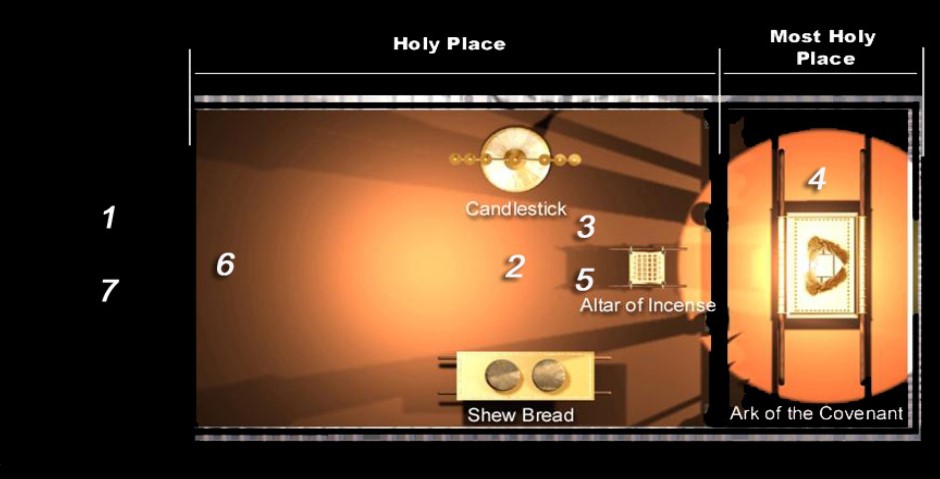
The Overlay and Bone Structure of Revelation.
We need to remember how the Old Testament sanctuary service is overlaid on top of Revelation forming bones for its structure. Each of the 7 visions are preceded by a sanctuary scene. Not only that but sanctuary imagery and language are interspersed throughout each of the visions. The Sanctuary was the Old Testament system that involved symbolic sacrifices, furniture, buildings and 7 Holy days (annual Sabbaths). The first half of Revelation is overlaid by the daily rituals of the sanctuary that centred on the slain lamb. The second half of the book is overlaid with the yearly ritual surrounding the Day of Atonement, the highlight of the Hebrew calendar.
In a nutshell: The 7 Churches (Revelation 2-3) are introduced by Jesus, our representative in heaven, walking amongst the candlesticks dressed as the High Priest. The 7 Seals (Revelation 6-7) were introduced by that amazing worship scene in heaven, (Revelation 4 & 5) with the ascending crescendo of praise that centred in the Lamb who was slain. This was Jesus’ coronation back into the Godhead following His ascension from earth, with the entire universe acknowledging the Divinity of the Lion/Lamb. The 7 Trumpets of Revelation 8-11 had Revelation 8:2-6 as their introduction as the angel stood at the altar of incense.
As we move to the centrepiece, the 7 Great Controversy scenes, we find these are preceded by John’s invitation into the Most Holy Place in Revelation 11:19, where he is given a virtual tour of this apartment of the Heavenly Sanctuary. There he sees the ark of the covenant. In this piece of furniture, we would find the two tables of stone upon which the 10 commandments were inscribed. The thunder, lightning and earthquake are reminiscent of Sinai where the law was inscribed on stone to show its permanence.
The 7 last plagues of Revelation 16-18 are preceded by another worship scene in heaven, equally as impressive as Revelation 4 and 5. This is the decommissioning of the sanctuary.
In Revelation 19 & 20 the 7 Great Controversy scenes are expanded. These are preceded by Revelation 19:1-10, another scene of Heavenly praise from the courtroom of Heaven involving the 24 elders and the great multitude. The Angels then announce the invitation to the Marriage Supper of the Lamb (to which you and I are invited! See you there!)
The 7-part New Earth Vision (Rev 21 & 22) is preceded by Revelation 21:1-8, the Doxology from the sanctuary, where it declares that God will again dwell with his people. That’s you and I.
Any interpretation of the Book of Revelation that does not pay attention to the emphasis on the Old Testament Sanctuary service is totally missing the point. At the head of this SMS is a diagram from a seminar I run outlining the various chapters of the book in relation to the Sanctuary. If you are unable to view the diagram, then go to my “Slide Share” site for Ross Chadwick and type in “The Sanctuary in the Book of Revelation.” This diagram represents Revelations journey through the sanctuary:
The numbers on the diagram correspond to the sanctuary scenes as mentioned in a previous SMS; they are as follows:
(1) Rev 1:9-20 on Earth -The Courtyard and place of the Altar of Sacrifice
(2) Rev 4 & 5 Inauguration of the heavenly Sanctuary ministry – in Heaven
(3) Rev 8:2-6 Intercession for His people – in heaven
(4) Rev 11:19 Judgment of the earth begins – in Heaven
(5) Rev 15:5-8 Cessation of intercession – in Heaven
(6) Rev 19:1-10 Worship again in the heavenly sanctuary –in heaven
(7) Rev 21:1-8 on Earth, God again dwells with His people.
Notice there is a chiastic structure to this; 1 & 7 match, 2 & 6 match, 3 & 5 match, 4 is the apex and therefore the most important. The #4 you will notice is in the Most Holy Place of the Sanctuary where the High Priest alone went on the Day of Atonement.
Numbers 1 -3 focus on the daily service (The Tamid.)
Numbers 5-7 focus on the yearly service (Yom Kipper)
The first half of Revelation (1-11) is modelled on “Daily” service (Tamid) – Intercession.
The second half of Revelation (12-22) is modelled on the yearly service (Yom Kippur or the Day of Atonement) -Judgment.
